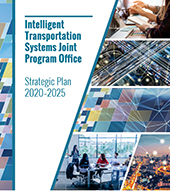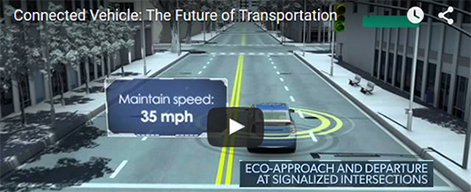News & Information
Everything You Need to Know About Connected Vehicle Deployments
One of the primary research focuses of the U.S. Department of Transportation (USDOT) over the past decade has been investigating and testing connected vehicle technology, which enables vehicles to communicate with each other and the infrastructure around them through a secure wireless communications network. This state-of-the-art technology will advance our nation's transportation system, improving safety, mobility, and the environment. Federal connected vehicle research has produced a considerable body of work to support pilot deployments, including concepts of operation and prototyping for more than two dozen applications.
Based on the successful results of the Connected Vehicle Research Program, the USDOT started pursuing a robust Connected Vehicle Pilot Deployment Program. This program serves as a mechanism to expedite the implementation of connected vehicle technology. In 2016, the USDOT awarded three cooperative agreements collectively worth up to $45 million to the New York City Department of Transportation, the Tampa Hillsborough Expressway Authority, and the Wyoming Department of Transportation to pilot next-generation connected vehicle technology. The three pilot sites are transforming their communities by designing, building, and testing the nation's most complex and extensive deployment of integrated wireless in-vehicle, mobile device, and roadside technologies.
Through the Connected Vehicle Pilot Deployment Program, the USDOT is now focusing on accelerating the deployment of this life-saving technology in more regions throughout the nation. The USDOT's goals for the program are straightforward -- advance deployment, measure impact, and uncover and address the technical and non-technical barriers to deployment in a hands-on way.
To help communities across the nation plan for connected vehicle deployments, the Intelligent Transportation Systems Joint Program Office (ITS JPO) offers a variety of resources for all types and levels of professionals -- including transportation planners, managers, and engineers at state and local agency levels.
The Connected Vehicle Pilot Deployment Program web site includes up-to-date information on the three pilot deployment sites, as well as deployment resources such as sample deployment concepts, real-life lessons learned, and deployment assistance. Discover everything this site has to offer by visiting: https://www.its.dot.gov/pilots/.
The New York City Connected Vehicle Pilot provides an ideal opportunity to evaluate connected vehicle technology and applications in a dense urban transportation system. The New York City Department of Transportation is installing connected vehicle technology in infrastructure and vehicles -- including cars, buses, and limousines -- that frequently travel in Midtown Manhattan.
- Learn more by visiting the USDOT New York City pilot site.
- Watch the New York City pilot video.
- Read the New York City pilot fact sheet.
The Tampa Connected Vehicle Pilot focuses on solving peak rush-hour congestion in downtown Tampa and protecting the city's pedestrians by equipping their smartphones with the same connected technology being installed in the vehicles. Tampa is also measuring the environmental benefits of using connected vehicle technology.
- Learn more by visiting the USDOT Tampa pilot site.
- Watch the Tampa pilot video.
- View the Tampa pilot fact sheet.
The Wyoming Connected Vehicle Pilot focuses on the efficient and safe movement of freight through the I-80 corridor, which plays a critical role in the movement of goods both domestically and internationally. The Wyoming Department of Transportation is developing applications that use connected vehicle technology to support a range of services, including roadside alerts, parking notifications, and dynamic travel guidance.
- Learn more by visiting the USDOT Wyoming pilot site.
- Watch the Wyoming pilot video.
- View the Wyoming pilot fact sheet.
The Connected Vehicle Pilot Deployment Program's Connected Vehicle Applications website provides information on specific connected vehicle applications that are being used by the pilot deployments. For detailed application descriptions and supporting documentation, visit: https://www.its.dot.gov/pilots/cv_pilot_apps.htm.
The USDOT's Success Stories and Lessons Learned website includes valuable information and best practices from communities who are at the forefront of deploying this innovative technology. To learn more, visit: https://www.its.dot.gov/pilots/success_lessonslearned.htm.
The ITS ePrimer provides transportation professionals with fundamental concepts and practices related to connected vehicle and other ITS technologies. This online resource can help practicing professionals and students better understand how ITS is integrated into the planning, design, deployment, and operations of surface transportation systems. To view the ePrimer, visit: https://www.pcb.its.dot.gov/eprimer/default.aspx.
The USDOT's ITS Professional Capacity Building Program offers free webinars designed to help agencies feel confident about deploying and operating ITS technologies and connected vehicle systems: https://www.pcb.its.dot.gov/t3_webinars.aspx.
USDOT Sample Pilot Concepts are hypothetical but realistic examples of localities applying the pilot deployment concept development process. Access these connected vehicle deployment concepts at: https://www.its.dot.gov/pilots/cv_pilot_deployment.htm.
Get technical assistance with connected vehicle devices and applications through the Connected Vehicle Help Desk: https://cvcs.samanage.com/login.
The ITS JPO and Connected Vehicle Pilot sites recently gave a presentation on How to Bring Connected Vehicles to Your Community:
https://www.its.dot.gov/pilots/pdf/CVP_SXSW2018_FINAL.pdf.










